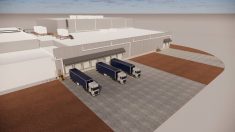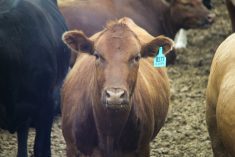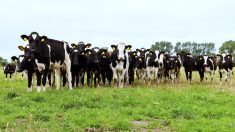Peggy and Harmen Hondebrink didn’t see a way to start dairy farming on their own before Alberta Milk introduced its New Entrant program nine years ago.
“It’s not something you can just start out of nothing,” said Peggy Hondebrink, who now operates a dairy farm with husband Harmen east of Rocky Mountain House.
“To buy our own brand new milking equipment and quota, we couldn’t do that. Without the New Entrant quota, we would never have been able to start.”
The couple knew they wanted to make a go of farming on their own — but they also knew that land prices along with equipment and infrastructure costs were going to put a brake on those plans. Peggy had grown up on a beef farm, so that was an option, but her in-laws were dairy farmers and Harmen had plenty of experience milking for other farmers.
It was on one of those days that Harmen came home bursting with ideas for improvements they could make at work when Peggy asked him, “Why don’t we start our own farm instead?”

As luck would have it, Alberta Milk announced a brand new program to attract new entrants to the industry right around that time. Through the New Entrant Assistance Program, aspiring dairy farmers are loaned two kilograms of quota from Alberta Milk for every kilogram of quota they purchase (up to 25 kilograms of quota a day) to help them get a foot in the door.
“The cost is a well-known barrier to the industry, especially the price of quota,” said Jonathan Ntoni, policy analyst at Alberta Milk. “It changes from month to month, but it’s well above $40,000 at this point. So the program is designed to help new farmers who are interested in dairy farming get into the industry.”
Read Also

Dennis Laycraft to be inducted into the Canadian Agricultural Hall of Fame
Dennis Laycraft, Executive Vice President of the Canadian Cattle Association, is one of this year’s inductees into the Canadian Agricultural Hall of Fame. Laycraft was nominated for his many contributions to the cattle industry.
So the Hondebrinks applied — and the rest is history.
The couple bought all of their equipment used “at a very reasonable price” from a farmer who was leaving the industry and started their business eight years ago with only 17 cows. Today, they milk around 50 cows.
And while the program allows participants to expand to 100 kilograms per day of total quota holdings (or about 80 to 100 cows), the Hondebrinks have no plans to expand any time soon.
“Bit by bit, we build as we go,” said Peggy. “It’s just my husband and myself, so we’re quite happy to just have 50 cows. That’s enough work for the two of us.”
The program also offers participants a support system as they navigate their new industry, including a mentor.
“The program application guidelines require you to identify an existing dairy farmer as a mentor to help you understand the business,” said Ntoni. “So the mentoring component is also a benefit.”
Peggy agrees.
“There are lots of people around who are willing to help,” she said. “You can count on the community to support you, and that’s nice.”
Even so, the past eight years have been a “real learning curve” for the couple, and outside challenges — such as uncertainty around trade deals, feed availability and weather — have been a struggle, especially in the last two years. But the couple is still hopeful about their future in the industry, including a new dairy-processing plant that’s expected to open in the spring of next year near Lacombe.
“Dairy farming is such a unique way to farm with the commitment level it takes,” said Peggy.
“As a dairy farmer, you have to really commit, and that’s hard to do. It’s hard to compete against the oil and gas lifestyle. But because we have good marketing boards, these opportunities still exist. And if it’s something you really want, you’ll get there.”
Alberta Milk will be accepting applications to the New Entrant program until March 31. Applicants must provide information on several fronts, such as their vision for their farm, proposed management plan, their anticipated land base and facilities, and business plans (a detailed two-year plan and a more basic 10-year plan).
For detailed information or to apply, visit albertamilk.com.















